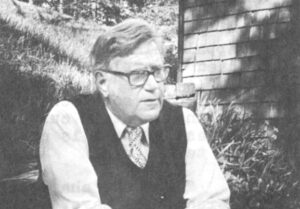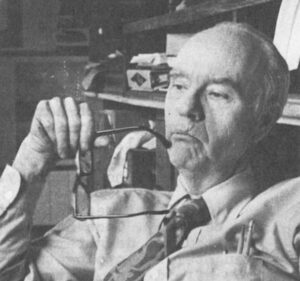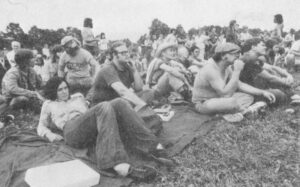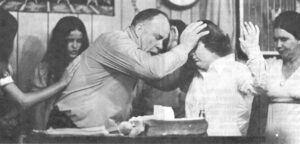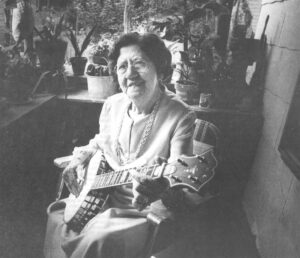Two hundred years have passed since the first white settlers made their early arduous steps into the Appalachian wilderness, but those two centuries have brought America no closer to understanding the people of the Appalachian culture than when the culture was born.
The old ways of the mountains are disappearing. In their place are festivals dedicated to the memories, slick commercial extrapolations of the mountain cultures and small, and seemingly ineffectual, groups of “new Appalachians” who desire to see a new culture built on the best of the old values.
The future of the culture is clouded. There are those who say the culture is dying, if it is not dead already.
The resurgence of interest in Appalachia is but a death rattle, an indication that the real culture is dead and the romantic visions of the culture are about to destroy the remnants. That’s the opinion of Dr. Norman O. Simpkins, chairman of the Department of Anthropology at Marshall University in Huntington, W.Va., and a leading authority on the folk culture of the southern mountains.
“The same thing happened with the cowboy cultures,” Dr. Simpkins observes. “About the time the cowboy culture was dying, Hollywood picked up the pieces and romanticized it. Even today cowboy movies are some of the most popular. But, the life portrayed in the cowboy movies is nothing like the real thing.”
If Dr. Simpkins is correct and if the Appalachian culture is beyond saving, it might be said that the folk culture was the only one of its kind to have survived two centuries without ever being studied systematically or dealt with successfully.
History proves that the culture flourished in relative isolation for a century and one-half before mainstream American culture began making inroads.
Those first settlers who came with the early westward migration made the mountain valleys their home for reasons still unknown. Some claim they were escaping the authorities on the populated East Coasts. Some, including Dr. Simpkins, claim that the Appalachian settlers were primarily Scotch-Irish who left their homeland in Northern Ireland during the 18th Century to escape British oppression.
But the heritage of the culture is disputed. While many adhere to the Scotch-Irish theory, others believe Appalachia was settled by outcasts from England’s big cities, particularly London.
Harry Caudill of Whitesburg, Ky., a noted Appalachian author, claims in his book “Night Comes to the Cumberlands” that most of the Appalachian region was populated by the “dregs of London society.” Caudill suggests that ignorance and poverty were with the people before they arrived in Appalachia. And, Caudill claims, the reason the London outcasts settled in the mountains is because other, more intelligent, people knew the steep mountains were of little value in an agrarian society.
Thus, the smart ones moved westward.
No one disputes, however, that the Appalachian people developed a folk culture that permeated the mountains. The culture tended to absorb those who moved into Appalachia. Whether they were Eastern Europeans, Spaniards or Italians, if they lived there long enough to have children, their children were mountain people.
The fact that the mountain culture was able to absorb other cultures with little or no change itself indicates just how strong the culture was. It wasn’t until the third decade of the 20th Century that the culture was brought to its knees by mass culture.
It’s difficult to determine just when and where the decline and fall began. It’s clear, however, that the governmental recovery programs of the Great Depression Era brought new ideas and new lifestyles into the mountains. The idea of mass giveaway programs was alien to the strong, proud and fierce mountain people.
Jim Comstock, editor of the “West Virginia Hillbilly” at Richwoods, says there was a time when mountain people felt it improper to work at any “public works.” The depression brought massive public works programs to Appalachia, and, since such programs were the only work available, mountain people were forced to change their attitudes.
Perhaps this was the beginning of the end of the mountain culture, but mass media, particularly television, must share a large portion of the blame.
Television has helped ease the isolation of the mountains which is one of the most negative aspects of Appalachia. It’s little wonder that even the poorest of families in the mountains often has an expensive television set and huge antenna perched atop its modest dwelling.
Television has opened a world to the isolated people which was not available before. But, it has brought an end to the colorful speech patterns of many Appalachians.
Comstock suggests that television has brought a revolution in how mountain people learn as well. Once the skills needed to survive in Appalachia were passed from one generation to another. Now, because of television, more is learned from television than from parents and grandparents. And, the skills taught on television are not necessarily those needed in Appalachia.
The list of cultural corrosive agents goes on. The war on poverty in the 1960s brought federally sponsored welfare programs to an area much in need of an economic uplift. But some believe the war on poverty was more a war against a culture since little or no concern was given the mountain culture when the programs were undertaken. In fact, it can be argued that the war on poverty was a repeat of the Roosevelt-era programs which some say triggered the culture’s decline.
The Appalachian Regional Commission, an outgrowth of the 1960s concern for Appalachian economics, has given millions for public works projects in the mountains, but not a penny for cultural preservation or protection. Some believe that the Appalachian corridor highways, which cut through the heartland of former cultural strongholds, have dislocated communities and brought highways to areas where people need better local service roads much more than they need modern transportation links with the outside world.
Perhaps it was the black awareness movement of the 1960s which led some mountain people to reassess their relationship with their culture. But whatever the reasons, there are the beginnings of an Appalachian awareness movement in the mountains, spawned by a concern for what is happening to a culture which has nurtured and protected millions of mountain people in the last 200 years.
A number of communal experiments have grown up around the Appalachian mystique. Don West of Pipestem, W. Va., has developed a thriving Appalachian South Folklife Center where young mountain people are taught the positive aspects of their cultures.
Numerous projects have been initiated at Appalachian colleges and universities aimed at preserving the Appalachian past. One of the strongest of these is at Alice Lloyd College at Pippa Passes, Ky., where the oral and photographic histories of the region are being preserved.
The Appalachian heritage movement has reached the secondary school system as well. Until recently, for instance, West Virginia history was taught in a hit-or-miss way in state schools. Within the last five years, however, the law has been changed making it mandatory for all West Virginia children in the eighth grade to have a full year of state history, with an emphasis on the study of the state as part of the Appalachian region. The state school system has begun training eighth grade social studies teachers in Appalachian culture. Seminars on Appalachian studies are conducted several times a year at various locations throughout the state.
Federal arts and humanities programs aimed at preserving and protecting aspects of the culture are scattered throughout the region. Thus, the same government that once seemed bent on destroying the culture now gives financial aid to save it.
But it may be too late. If Dr. Simpkins’ theory is correct, all the programs and projects may be in vain. There may not be enough cultural remnants left for anyone to repair it.
If that’s the case, is there any reason for preservation and protection programs? The fact that there are those still trying to live a more-or-less traditional Appalachian life seems to indicate a need for protection.
Mainstream American culture may not be for everyone. There will always be those who seek alternative life styles. The fact that the Appalachian culture persisted for so long indicates it offers a lifestyle capable of satisfying experiences.
The era of the Appalachian culture may be gone, but there may be time to build and protect a new Appalachian culture based on values found in the old but modified somewhat to meet the challenges of the new age.
And, since those living in the “new Appalachia” will have chosen the culture instead of being thrown into it without regard to personal choice, some say there’s a chance the new culture will be much stronger and even more persistent than its forerunner.
Received in New York on October 6, 1975.
©1975 Dave Peyton
Dave Peyton is an Alicia Patterson Foundation award winner on leave from The Huntington Advertiser (West Virginia). This article may be published with credit to Mr. Peyton, The Huntington Advertiser, and the Alicia Patterson Foundation.

